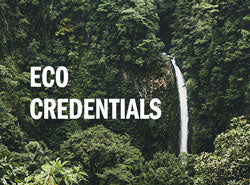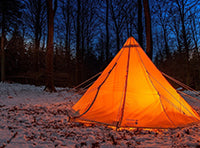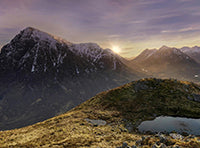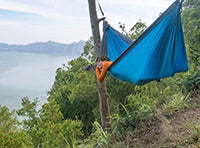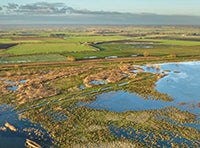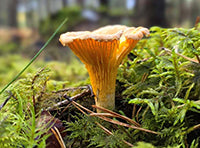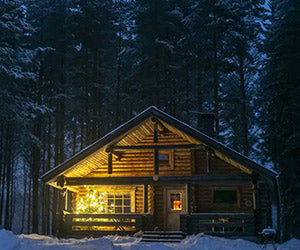Leave no trace. It sounds simple, but what does it actually mean? In short, after you’ve spent a night wild camping, no one should be able to tell that you were ever there.
There are 7 founding principles of Leave No Trace, designed to provide an easily understood framework of good practice for anyone visiting the outdoors. Originally developed in the USA to preserve and protect the pristine wilderness areas of the 'backcountry', Leave No Trace has since been adapted for other landscapes and settings. The original principles are: Plan Ahead & Prepare, Travel & Camp on Durable Surfaces, Dispose of Waste Properly, Leave What You Find, Minimise Campfire Impacts, Respect Wildlife and Be Considerate of Other Visitors.
When it comes to wild camping, that basically translates as the following:
- Pack it in, pack it out
- Don’t disturb the environment
- Be inconspicuous
- Arrive late, leave early
- No big groups
- Respect others
- Don’t outstay your welcome
- Practice good toilet hygiene
- Don’t pollute water sources
- No fires
Everything you take with you, you must take away with you. It’s good to think about this when you are packing and only take things you’re happy to carry out. This includes all rubbish and even food waste. That means banana skins, orange peel, used toilet paper. The lot. Once you’ve packed away your tent, walk around the area and double check you haven’t left anything behind other than a patch of flattened grass.
Don’t be tempted to hack back vegetation, move stones or rearrange logs in order to create a place to pitch. Find somewhere that you can just set up your tent on the land as it is. If you have to move small sticks and stones, ensure you put these back where you found them before you leave.
When wild camping, large, brightly coloured tents are out. Not only would these be heavy and cumbersome to carry in, they are also very easily spotted from a distance. Wild camping is all about blending into the landscape, so take the smallest tent you can get away with, ideally in neutral tones. The idea is not to be seen by others and not to be a blight on the landscape.
The less time you spend at your wild camp spot, the fewer disturbances to nature and wildlife you will cause. If you are aiming for a specific wild camp spot, time your walk in carefully so you arrive just before nightfall and can pitch in the fading light. Don’t hang around in the morning. Break camp early and move on.
The bigger the group, the bigger the disruption to the environment. Keep your group size low and be respectful when camping with others. Noise travels easily from tents in the great outdoors and although there may not be other humans close-by, don’t forget there’s a whole host of wildlife right on the doorstep which you could be disturbing.
On a wild camp you’ll often feel like you’re the only people on the hills. However, there are often others who are out trying to enjoy the same wild places as you. People escape to the hills for different reasons, so while some will be adventuring with friends and may be up for a late night of chatting and laughter under the stars, others will be alone seeking solace in the sights and sounds of nature. Given how easily noise travels in the great outdoors, it’s important not to play music or use noisy technology.
Leaving your tent up in the same spot is a blot on the landscape and can harm vegetation. That’s why it’s best to only stay one night in one place, then move on. That way you avoid the grass underneath your groundsheet starting to die. It should simply spring back up after you’ve left. Think about it. If somebody gets out for a morning walk to enjoy the peace and tranquillity of their favourite mountain lake, they don’t want to find you there, enjoying a leisurely 11am espresso outside your bright yellow tent.
One of the most frequently asked questions concerning wild camping is what to do when you’ve got to go. Pack a trowel, some toilet roll, and a sturdy ziplock bag to carry out used toilet roll. Find a spot more than 30 metres away from any water source and dig a hole at least 15cm deep. Do your business and put used toilet roll in the bag. Do not bury the paper or sanitary items – animals will dig them up. They must be carried out with you. Fill the hole with soil and replace the turf.
As well as ensuring you don’t contaminate water sources by going to the toilet nearby, it’s important to be careful when washing up or even washing yourself. If you need to rinse pots and pans, fill up a container with water and take your washing up at least 30 metres away from the water source. Don’t wash with soap in streams or rivers either. Again, use a water container and eco-friendly products, disposing of wastewater at least 30 metres away. This isn’t only important for wildlife but for fellow wild campers too – after all, there are likely to be other people using the same water as you.
The Leave No Trace code is to 'minimise campfire impacts'. Generally, the easiest way to do this is to avoid lighting fires unless you need one, and realistically if you're wild camping in the UK, you don't need to make a fire.
Lighting a fire makes it much harder to abide by the other leave no trace principles. For one, clearing up a fire takes time, making it difficult to leave early. Fires are also conspicuous and tend to attract attention, making it way more likely that you'll get moved on. And if a landowner discovers you, they'll be far more irate if you've started a fire on their land.
It's also rarely practicable. If you're wild camping in places like Snowdonia or the Lake District, you should be above the highest fell wall, which means you'll probably be above the treeline, so there isn't going to be adequate fuel anyway. And if you're stealth wild camping lower down, you're likely to be closer to human habitation, where if someone sees smoke from a fire they'll likely call the fire brigade (or the police).
To be honest, if your primary motivation for going wild camping is to light a fire, then we'd suggest it's probably not the activity for you. You'll be far better off going to a low impact or 'nearly wild' campsite, where you can have a fire. Or book onto a bushcraft weekend and learn how to make and control a small-stick fire.
Remember that the risk of starting fires on certain types of ground is very high, especially in the summer months. Moorland is especially susceptible and accidental fires can cause widespread damage which costs a huge amount of money to restore, not to mention risks to wildlife and livestock.
Far better to use 'contained' fire, like a backpacking stove, a Kelly Kettle, a Bushbox or a Fire Safe. It’s still important to set your stove up on a spot where you won't scorch the ground. Always source wood responsibly, using only deadfall branches and twigs. Do not leave the fire unattended, ensure it is properly extinguished before bed and be prepared to carry out ash the next day.

